

--Howard Sutherland
Please note Howard Sutherland's words of wisdom! To find the correct spoke length when building a wheel, you need dimensions of the rim and hub. There are manufacturers' specifications and lists of rim and hub dimensions online -- including Damon Rinard's list on this site, BUT, only after you have mostly laced up a wheel will you discover whether spoke length is correct. So, measure, even if you think you know the correct dimensions. Online information is, to be sure, useful in identifying parts and in confirming your measurements.
This article describes how to measure, with an emphasis on the use of simple, low-cost tools, and describes the level of accuracy needed.
Spoke lengths are given in millimeters, so you need to come up with measurements in millimeters. Some of the measurements in this article use a tape measure divided in inches, and the article shows how to convert to millimeters.
You may skip over this section in case you like. You don't have to know the formula for spoke length. Spoke length calculator software does the number crunching for you.
 But in case the math interests you, here's how spoke length is calculated. It's a problem in trigonometry, in two steps.
But in case the math interests you, here's how spoke length is calculated. It's a problem in trigonometry, in two steps.
The first step is to calculate the length of the third side of a triangle according to the cosine rule formula,
_________________
C = \/A2 + B2 - 2AB cos θ
where
A is indicated by the purple line in the illustration at the left, and B by the orange line. C (in red) is the third side, the one you calculate.
The two known sides (A and B) are the radius (half diameter) of the circle of spoke holes in the hub flange, and the radius of the circle of spoke holes of the rim. The angle θ depends on the number of spoke 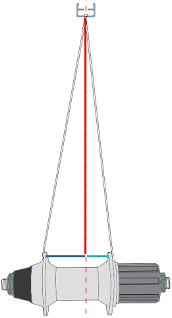 holes and the spoking pattern.
holes and the spoking pattern.
The first step creates a virtual measuring point directly below the spoke holes in the rim. There's nothing to measure directly there, and that's why a second step is needed.
The second step gives the spoke length, by accounting for the spacing of the hub flange away from the centerline. This step applies the Pythagorean Theorem for the hypotenuse (slant side) of a right triangle, with a slight correction to account for the size of the spoke holes in the hub:
_______
L =\/ C2 + w2 - d/2
where:
Each of the hub's two flanges may be a different distance from the centerline, as indicated by the blue and green lines -- image modified from one by keithonearth on Wikipedia.
When taking measurements, record the following information. You need this information to do your calculation, and to make a correction for the next wheel, if the spoke length turns out slightly incorrect with your first one.
You need to know the number of spoke holes of the rim and hub. Normally, these must match, though it is possible and sometimes useful to build a wheel with some mismatched combinations. We have an article about that. If the hub is very large, as with many electrically-assisted bicycle hub motors, that article will show how to reduce spoke angle at the rim and avoid spoke breakage.
Also, some hubs and rims have unevenly-spaced spoke holes, but we're not going to discuss them here. We'll have another page for them soon!
Measuring a rim is usually done in three steps:
A rim may have a single-wall or double-wall cross-section, as shown in the image below. A double-wall rim has recessed spoke holes: the smaller holes closer to the center of the wheel hold the spokes. The larger holes in the wall which faces the tire allow access when building the wheel.
Steps 2 and 3 in the list above are necessary with recessed spoke holes, because you can't measure the spoking diameter directly.
| Rim cross-sections | ||||
|---|---|---|---|---|
| Rim without eyelets | Rim with eyelets | Rim with recessed spoke holes and no eyelets | Rim with recessed spoke holes and eyelets | Socketed rim with eyelets |
 |
 |
 |
 |
 |
The illustration below shows the outside diameter and the spoking diameter. The rim shown is a double-wall rim with recessed spoke holes and no eyelets.
Cross section showing rim outside diameter
and spoking diameter. The spokes attach
at the deeper, smaller holes in this double-wall rim.

Lay a measuring tape or ruler across the rim between two points directly opposite one another. Slide one end of the tape back and forth along the rim until the measurement is largest. Measure at three or four different angles spaced equally around the rim and take the average, in case the rim isn't perfectly round. (Spoke tension will make the rim round later, unless the rim is really bad. Then start with another rim.) Measure to the nearest 1mm or 1/32 inch, or better. If the diameter falls partway between millimeter or 1/32 inch marks on the tape, you could estimate the fraction.
If you measured in inches, multiply by 25.4 to get the diameter in millimeters. Convert the fraction after the last even inch to a decimal before multiplying: for example, 1/4" is 0.250, so a rim that measures 24 1/4 inches is 24.250 inches in diameter, or rounded to the nearest 1/10 millimeter, 616.0 mm. .
![]()
![]()
If you are working with an empty rim, it is easy to measure the outside diameter, but if you need to measure a built-up wheel, the axle gets in the way of the tape measure. You then need to measure the circumference (distance around the rim). Also, measuring in two different ways is possible, and a good idea. As carpenters say, "measure twice and cut once" or in this case, measure twice and select spokes once.
You can measure the circumference of a rim by wrapping a measuring tape all the way around the rim. You then derive the diameter from the circumference.
A narrow, metal tape measure -- 1/4 inch or 6 mm wide -- will fit into the well of the rim (the deepest part of the rim's channel). (A wide metal tape measure won't fit into the well of most rims and won't curve smoothly around the rim.)
Don't trust a fabric measuring tape as used in fitting clothing. The fabric stretches.
Use the metal tape measure as shown in the image below.
Here are the steps to measure a rim using the circumference:
If you don't have a narrow tape measure, you could wrap a bicycle cable inner wire around the rim, hooking the ferrule into the valve hole. Mark the wire, stretch it out flat and measure the length. If measuring a built-up wheel with non-recessed spoke nipples, the cable will sit next to them and the measurement is that for a bare rim.
You must measure the depth to the spoke holes if they are recessed, or if you measured the outside diameter of the rim.
You can use an improvised tool, as in the image at the right -- a bolt and nut, and a small metal ruler. Lay the ruler flat across the flanges of the rim. I
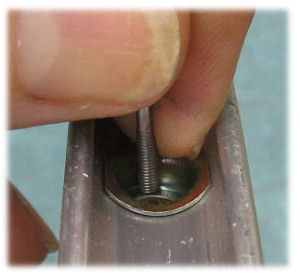
If you measured the circumference of the rim at the well, then measure the depth from the well to a recessed spoke hole, if the spoke holes are recessed.
If you are good at holding objects steady in your hands, you can even do the depth measurement with a bare bolt or bicycle spoke, as shown in the image at the left. Insert the spoke to the bottom of the spoke-hole recess, and slide your hand down the spoke until the fingernail of your index finger rests lightly against the side of the access hole.
Then as shown in the image at the right, transfer this measurement to the ruler, resting your fingernail lightly against its end.
The dimension you measured using the bolt or spoke is a difference in the radius --the distance from the center of the wheel to the outside. Spoke calculators use the diameter, which is twice the radius, because there's nothing to measure at the center of an empty rim. So, as you move on to final calculations, you'll be subtracting twice the depth you measured with the bolt or spoke.
Now you need calculate the spoking diameter. Get out your pocket calculator or smartphone app (or a paper and pencil if you're retro or the battery is dead).
We'll calculate our spoking diameter using both of our sets of measurements, and see how the results compare.
The measured outside diameter of our rim is 20 7/8 inches, or 20.875 inches. Multiplying by 25.4 gives 530.2 mm. The measured depth from the outside of the rim to the spoke hole is 11 mm. Twice that is 22 mm, and so the spoking diameter measures as 508.2 mm.
The circumference of the well measures as 64 1/8 inches, (64.125 inches). Multiplying by 25.4 converts to 1629 mm; then dividing by pi, the diameter at the well is 518.5mm. The depth of the recessed spoke holes is 5mm; twice that is 10mm and so the spoking diameter measures as 508.5mm.
So, we got 508.2 mm by measuring the diameter and 508.5 mm by measuring the circumference. Close enough!
Finally: If you measured over the tops of spoke nipples, you are done. If you measured an empty rim, add twice the height of a spoke nipple -- about 4mm total. This measurement should agree with the one according to Damon Rinard's method (see below).
Damon Rinard describes another method to calculate rim diameter, but I think it is more complicated.
The handy Sutherland Rim Diameter System simplifies measurement of the rim. By using a tape with a special scale, this system calculates the diameter for you -- saving time, and time is money if you build a lot of wheels. The Sutherland system includes a tool to find the effective rim diameter for spoking.
Howard Sutherland demonstrates the Rim Diameter System in the video below:
![]()
![]()
To determine spoke length, you also need measurements of the hub: the diameter of the circle of spoke holes, the diameter of a spoke hole, and the flange spacing from the centerline.
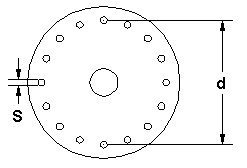
The axle gets in the way when measuring the diameter of the circle of spoke holes (d in the image at the right). The spoke hole diameter (S) also affects spoke length.
The traditional way to measure the spoke hole circle diameter is with a caliper, as shown in the image below, center to center of the spoke holes, but it's easier to measure from the right side to the right side, or left side to left side. You can't get a "contact" measurement this way, but inaccuracy of a small fraction of a millimeter isn't going to be important here. If you're a real stickler, you could insert the outside-measuring blades of the caliper into the spoke holes to take a smaller measurement, and the inside-measuring blades (at the top in the picture) to do a larger measurement, then take the average. Subtracting the smaller from the larger measurement and dividing by two would also give you the diameter of the spoke holes -- but that is usually 2.5 to 3 mm, and the resulting difference in spoke length isn't large enough to matter.
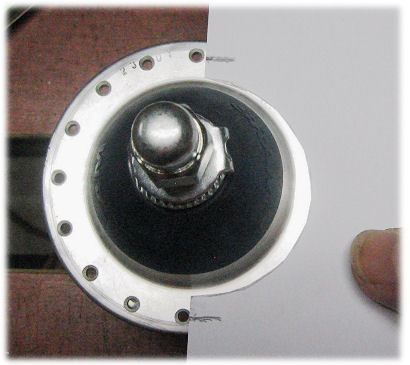
A hub flange farther from the centerline requires longer spokes, but only slightly longer with most wheels because the spokes approach the hub at a high angle.
Usually with a front wheel or the left side of rear wheel, you can go with a typical spacing of 35 mm, and with the right side of a rear wheel that has multiple sprockets, 20 mm.
The drawing below is of the same hub shown in the previous two photos (a SRAM DualDrive hub, a 3-speed with a cassette body for hybrid gearing). The dimension in red is the OLD (overlocknut distance), and the dimensions in blue and green are the flange spacings. They are very near the generic ones already given.
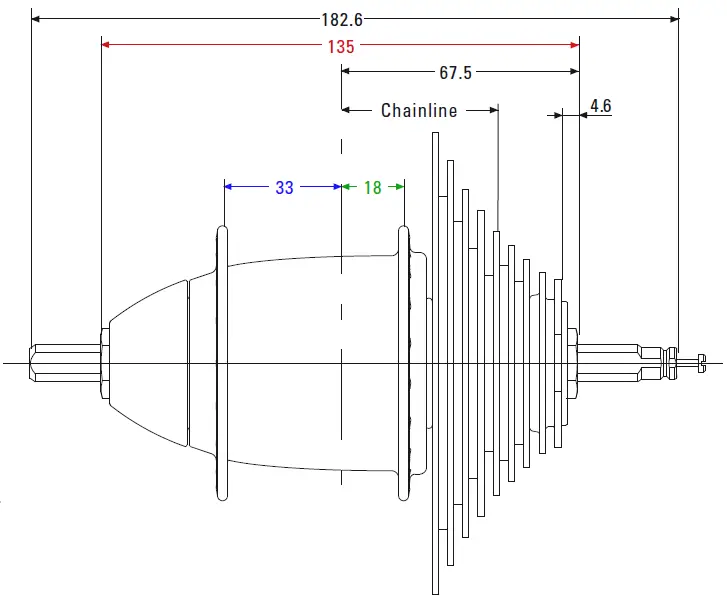
With unusual hubs, and especially with a large hub in a small rim, you must measure the flange spacing, or read dimensions from hub specifications. If both flanges are the same distance from the centerline, measure the spacing between the flanges and divide by two. If the two flanges are different distances from the centerline, measure them independently. Resting the locknut against the edge of a workbench or table makes measurement easier. An example is shown below, using the same hub.
Both ends of the hub are measured. First, let's measure from the right end. The right flange is 50mm to the left of the right locknut, and the left flange is at 100mm to the left of the right locknut.
Next, turning the hub over and measuring the other end, the left flange is 35mm from the left locknut.
Calculating now, the overlocknut distance is 135mm, as in the manufacturer's specification in the drawing above. Half that is 67.5mm. The right flange, at 50mm from the right locknut, is 67.5-50mm or 17.5mm from the centerline of the hub and the left flange at 35mm from the left locknut is 67.5-35mm or 32.5mm from the centerline. These measurements are not an exact match for the manufacturer's specifications, but are close enough for all practical purposes.
Some rims have spoke holes closer to one side than the other, to reduce dishing when the hub has unequal flange spacing. Then subtract the offset of the spoke holes from the hub flange spacing of the same side as the offset, and add it to the hub flange spacing for the other side. For example, if the left flange of the hub is 35 mm from the centerline, the right flange 20 mm from the centerline and the spoke holes in the rim are offset 3mm to the left, then the effective flange spacing is 32mm on the left and 23mm on the right.
Damon Rinard has another description of hub measurements on this site.
The final measurements you need to calculate spoke length are
Spoke length calculators are online or downloadable.
Some spoke calculators, including Damon Rinard's Spocalc on this site, perform only the mathematical calculation described earlier in this article. Other spoke calculators account for the stretching and seating of spokes and shrinkage of the rim in a tensioned wheel -- about 1 millimeter of spoke length in a typical wheel. If the spoke calculator already accounts for tension, then specify spoke length based on where you want the ends of the spokes to reach.
How accurate do your measurements need to be, and what tools are good enough?
A tape measure to take the circumference of a rim should be 1/4" or 6 mm wide, and must be at least 8 feet or 2.5 meters long to reach all the way around a typical bicycle rim -- longer for oversize rims (32" and 36" wheels, antique high-wheelers...) but you could measure these wheels, or any wheel, using the diameter, or bicycle cable as described earlier.
Generally, metal rulers with etched markings are highly accurate, and tape measures of reputable brands (Stanley, Craftsman etc.) are accurate enough, but do check yours against an etched metal ruler -- and the longer the ruler, the better. A tape or ruler of plastic, fabric or wood cannot be trusted. Plastic and wood expand and contract with changes in temperature and humidity; fabric also stretches.
Spoke length is measured from the inside of the elbow, as shown in the image below, to the threaded end.
When measuring a spoke using a tape measure, a second spoke may be used to hold the elbow of the spoke and the tape measure's tab, as shown.
The threaded end of this spoke measures at 11 29/64 inches (halfway between the 11 7/16 and 11 15/32 marks on the measuring tape). A metric tape would make measurement easier, but let's calculate: 29/64 is 0.453125, and so the length measures as 11.435125 inches. (Yes, I know that the number of decimal places exceeds the precision of measurement, but digital calculators give you the extra digits at no extra cost.). Multiplying that number by 25.4 to convert to millimeters and lopping off meaningless decimal places gives 290.9mm. The ruler and the manufacturer's identified spoke length agree very well.
As long as your tools are good, selecting the wrong spokes for a wheel is more likely to result from an outright mistake than from a measurement error. Though you should always measure carefully, wheel measurement is more forgiving than you might think.
Errors in measurement of the rim's diameter result in only half as great an error in spoke length. Deriving the diameter from the circumference improves accuracy further by more than 3 times.
With common wheels, errors in flange distance from the centerline are of minimal importance: a 1 mm change in flange distance results in only about a 1/10 mm change in spoke length.
The importance of the hub spoke hole circle diameter depends on the spoking pattern. With a radial spoking pattern, spoke length changes at half the rate of the diameter of the hub flange. With higher cross numbers, the effect on spoke length becomes smaller and smaller. With a 36-spoke cross 4 pattern, the spoke holes are 90 degrees away from those in the rim, and the hub spoke hole circle diameter hardly matters at all. A 36-spoke cross 4 pattern pattern is a good choice when the hub's dimensions aren't known or with flanges of different sizes. With both wheels spoked this way, a bicycle tourist would need to carry only one length of spare spokes, despite different flange sizes on the front and rear hub, etc. etc.
The table below summarizes the effects of measurement errors.
Effect of measurement errors
| Measurement error in: | Spoke length will be off by this many times the error: | Note |
|---|---|---|
| Rim circumference | 1/6.28 (1/2π) | This is the most accurate way to measure for diameter. |
| Rim diameter | 1/2 | Must be measured at several angles and averaged |
| Depth from measured rim radius (1/2 diameter) to spoke hole | 1 | This is a difference in radius and applies to each spoke. |
| Hub flange spacing from centerline | About 1/10 | Error becomes worse for small wheels/large flanges. |
| Hub spoke hole circle diameter | Usually small, but up to 1/2 | Small for high cross numbers, 1/2 for radial spoking. |
| Spoke hole diameter | 1/2 | Unimportant because spoke hole clearance is small. |
| Tensioning compensation | -- | Spokes will be effectively about 1mm longer when tensioned. |
For typical wheels, random errors dominate, but for larger wheels, and particularly, very large wheels such as on antique high-wheeler bicycles, proportional errors -- from the scale of a measuring tape being slightly to large or small, and from spoke stretch under tension -- become important.
The ends of the spokes of a fully-tensioned wheel come to somewhere between the bottom and top of the slots in the spoke nipples. Properly-tensioned spokes stretch by about 0.3%, and rims compress slightly -- so, the 250-300mm long spoke in a typical large bicycle wheel needs to be about 1mm shorter than raw calculations would indicate.
The range of spoke lengths which avoids these problems is about 3mm. The tolerance has become smaller in recent years, because short spoke nipples and matching short threads are fashionable to reduce aerodynamic drag.
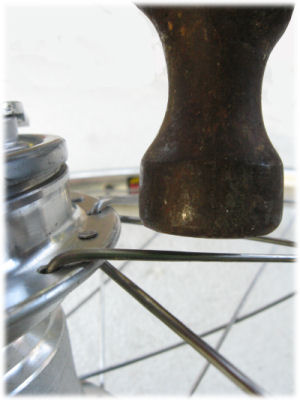 Spokes at the outside of the hub flanges may appear too short when lacing the wheel if they bow outward. You may need to tap on spokes lightly with the flat face of a hammer or mallet just outside the hub flange to straighten them so they reach the spoke nipples.
Spokes at the outside of the hub flanges may appear too short when lacing the wheel if they bow outward. You may need to tap on spokes lightly with the flat face of a hammer or mallet just outside the hub flange to straighten them so they reach the spoke nipples. The threads of all four spokes in the image below extend equally far. The leftmost nipple is threaded on until the threads start to bind. The next spoke nipple is threaded on until the end of the spoke is level with the top of the nipple's screwdriver slot, as far as it can go without risk to the inner tube. The rightmost nipple is threaded on only far enough to conceal the threads of the spoke, risking nipple breakage. Comparing the leftmost spoke with the bare one shows that the internal threads of the nipple extend down about as far as the base of the wrench flats.
I thank Roger Musson for permission to use the photo below, with cross-sectioned spoke nipples. The spoke threads are the same length in all three examples, but the spoke nipples are of different lengths. A spoke can be threaded in only until the red line in the picture reaches the bottom of the threading in the spoke nipple. Beyond that limit, it will bind. The combination on the left risks breaking the spoke nipple just below the head, because the spoke does not extend up into the head of the nipple. Only the short spoke nipple at the right is really suitable for the spokes shown.
